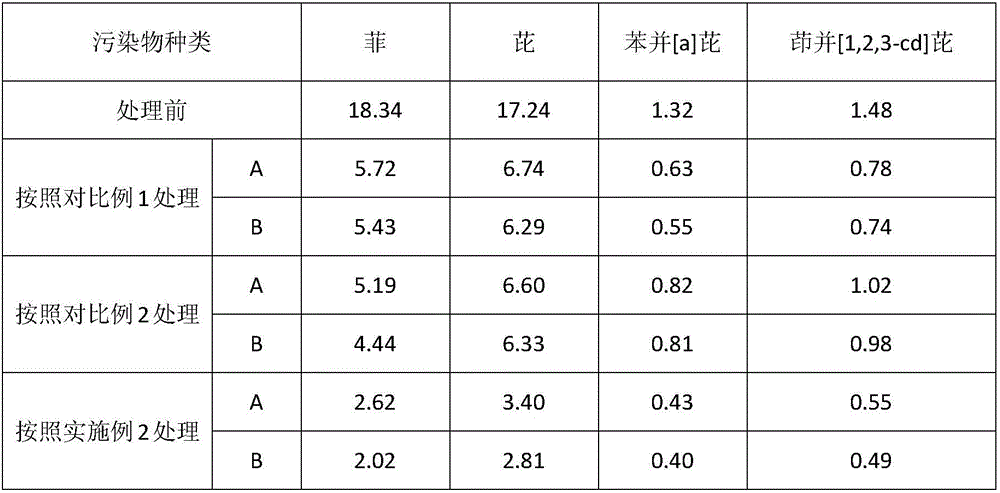Method for repairing soil contaminated by polycyclic aromatic hydrocarbon by combining fenton-like chemical oxidation and biological heap technologies
A technology of polluted soil and chemical oxidation, applied in the field of contaminated soil remediation, can solve the problems of limiting microbial degradation activity, disturbing soil microbial population, and difficult to deal with polycyclic aromatic hydrocarbons, and achieve the effect of shortening the remediation cycle, improving oxidation efficiency, and short cycle time
- Summary
- Abstract
- Description
- Claims
- Application Information
AI Technical Summary
Problems solved by technology
Method used
Image
Examples
Embodiment 1
[0047] 1. Preparation of soil samples.
[0048] Clean soil samples: use the subsurface layer (5-10cm) of ordinary soil. Remove rhizomes, leaves, etc., and pass through a 5mm sieve after indoor air drying. After determination, the PAHs content in the soil was lower than the detection limit, the organic matter content was 1.6%, and the pH=7.5. The clean soil samples were sterilized by autoclave with moist heat.
[0049] PAHs-contaminated soil samples: Spray a certain volume of acetone solution of phenanthrene, pyrene, benzo[a]pyrene, indeno[1,2,3-cd]pyrene evenly on the clean soil sample, so that various PAHs in the soil reach Set the initial concentration, place it in a dark place in a fume hood to completely volatilize the acetone in the soil, wrap the container with aluminum foil, set the temperature to 4°C, and store it for later use. The initial concentration was 18.34mg / kg of phenanthrene, 17.24mg / kg of pyrene, 1.32mg / kg of benzo[a]pyrene, and 1.48mg / kg of indeno[1,2,3-...
Embodiment 2
[0064] Process according to class-Fenton+ biological pile of the present invention:
[0065] ① Add H with a mass fraction of 30% to the heap three times 2 o 2 solution, with an interval of 6 hours, H 2 o 2 Volume mass ratio of solution to contaminated soil: 0.15L: 1kg for the first time, 0.10L: 1kg for the second time, 0.05L: 1kg for the third time, and react for 12 hours;
[0066] ② Spray β-cyclodextrin solution with a concentration of 20g / L on the pile, and its volume-mass ratio to the polluted soil is 0.1L: 1kg;
[0067] ③ Add the bacterial agent and the bacterial content is 10 9 cfu / g of the white-rot fungus-Pleurotus pellagra suspension, the volume-to-mass ratio of the white-rot fungus-Pleurotus pellagra suspension to the polluted soil is 0.3L:1kg;
[0068] ④Spray urea to the pile to adjust the ratio of nutrients C:N:P to 100:10:1;
[0069] ⑤ The air compressor blows air to the biopile through the aeration pipe to aerate the biopile for 1 hour, no less than twice a ...
Embodiment 3
[0077] 1. The contaminated soil for testing was collected from a farmland near a steel factory in Hunan. After being air-dried, it passed through a 5mm sieve. The organic matter content of the soil was determined to be 62.75g·kg -1 , pH=6.85, the content of phenanthrene is 56.25mg·kg -1 , the content of pyrene is 68.82mg·kg -1 , the content of benzo[a]pyrene is 15.56mg·kg -1 , the content of indeno[1,2,3-cd]pyrene is 11.14mg·kg -1 .
[0078] 2. Weigh 5000g of air-dried soil, 200g of magnetite, 100g of straw, and 200g of mushroom dregs, and mix them evenly;
[0079] 3. After mixing, put it into the reaction device. There is a ventilation pipe at the bottom of the device. Turn on the small vibrator for 1 hour, and turn it on once every 12 hours;
[0080] Add 30% H to the heap three times 2 o 2 Solution, 1L for the first time, 0.5L for the second time, 0.25L for the third time, react for 6h;
[0081] 4. Spray 0.5L of β-cyclodextrin solution with a concentration of 15g / L, 0...
PUM
 Login to view more
Login to view more Abstract
Description
Claims
Application Information
 Login to view more
Login to view more - R&D Engineer
- R&D Manager
- IP Professional
- Industry Leading Data Capabilities
- Powerful AI technology
- Patent DNA Extraction
Browse by: Latest US Patents, China's latest patents, Technical Efficacy Thesaurus, Application Domain, Technology Topic.
© 2024 PatSnap. All rights reserved.Legal|Privacy policy|Modern Slavery Act Transparency Statement|Sitemap



